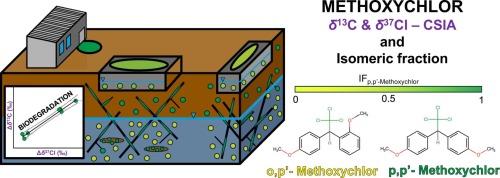Fate and degradation of methoxychlor in a contaminated aquifer: Insights from dual carbon-chlorine isotope analysis and isomeric fraction
IF 12.2
1区 环境科学与生态学
Q1 ENGINEERING, ENVIRONMENTAL
引用次数: 0
Abstract
The combined use of isomeric fraction (IF) and multi-element compound-specific isotope analysis (ME-CSIA) was evaluated for the first time to assess the fate and degradation of methoxychlor in the environment. The concentration and carbon and chlorine isotope composition of methoxychlor and its transformation products were monitored in water and solid phases of a fractured aquifer. The results from the interception trenches water samples demonstrated that induced alkaline conditions promoted alkaline hydrolysis. Natural attenuation of methoxychlor isomers was evidenced by carbon and chlorine isotopic fractionation. The field C-Cl isotope slope (ΛC/Cl = 0.42 ± 0.06; R² = 0.98) was statistically indistinguishable (p > 0.05) from that obtained in a previous experiment (0.44 ± 0.14), confirming the occurrence of reductive dechlorination of methoxychlor isomers. P,p’-methoxychlor δ13C values in groundwater samples revealed variations linked to rainfall patterns. The extent of p,p′-methoxychlor biodegradation was calculated to be greater than 89 % across the monitoring period. The combined use of CSIA and IF evidenced that alkaline hydrolysis and reductive dechlorination did not exhibit isomeric selectivity. Differences in IF values between slurry and water samples, as well as between upstream and downstream wells, suggested variations in the environmental behaviour of the p,p’ and o,p’-isomers, likely due to differing water solubilities. Overall, ME-CSIA proved to be a valuable tool for identifying, quantifying, and tracing methoxychlor degradation in this aquifer. Additionally, IF provided insights into the distinct environmental behaviour of the p,p′- and o,p′-isomers. These tools offer crucial information, valuable for decision-makers in developing remediation strategies for methoxychlor-contaminated sites.

求助全文
约1分钟内获得全文
求助全文
来源期刊

Journal of Hazardous Materials
工程技术-工程:环境
CiteScore
25.40
自引率
5.90%
发文量
3059
审稿时长
58 days
期刊介绍:
The Journal of Hazardous Materials serves as a global platform for promoting cutting-edge research in the field of Environmental Science and Engineering. Our publication features a wide range of articles, including full-length research papers, review articles, and perspectives, with the aim of enhancing our understanding of the dangers and risks associated with various materials concerning public health and the environment. It is important to note that the term "environmental contaminants" refers specifically to substances that pose hazardous effects through contamination, while excluding those that do not have such impacts on the environment or human health. Moreover, we emphasize the distinction between wastes and hazardous materials in order to provide further clarity on the scope of the journal. We have a keen interest in exploring specific compounds and microbial agents that have adverse effects on the environment.
 求助内容:
求助内容: 应助结果提醒方式:
应助结果提醒方式:


